(Page créée avec « Bait for Melipona bees ») |
(update property name) |
||
| (24 révisions intermédiaires par un autre utilisateur non affichées) | |||
| Ligne 1 : | Ligne 1 : | ||
| − | {{ | + | {{Tuto Details |
|Main_Picture=Appât_pour_abeilles_Melipona_Capture.PNG | |Main_Picture=Appât_pour_abeilles_Melipona_Capture.PNG | ||
|Licences=Attribution (CC BY) | |Licences=Attribution (CC BY) | ||
| − | |Description= | + | |Description=Bait made from accessible materials to help develop new bee colonies |
|Area=Food, Tools | |Area=Food, Tools | ||
|Type=Tutorial | |Type=Tutorial | ||
| Ligne 15 : | Ligne 15 : | ||
|IsTranslation=1 | |IsTranslation=1 | ||
}} | }} | ||
| − | {{ | + | {{Introduction |
| − | |Introduction= | + | |Introduction=Bait for Melipona bees was documented on during one of our trips, looking for low-techs in South America from June to September 2017 in Ecuador, Peru and Bolivia. |
| − | + | Don't be mistaken, the aim of this low-tech is not to kill bees but to attract them so they can create a colony and in the end...honey! | |
| − | + | Pablo, an Ecuadorian beekeeper uses this technique. He thinks this system is adaptable to all bee species but it has only been tested on the Melipona species for the moment. They are small bees that don't sting, they can be found in Mexico, Central America and South America. Pablo works in the Finca Fina farm near Malacatos in the South of Ecuador and looks after animals as well as bees, but his speciality is bees! | |
| − | + | These bees are micro-pollinators, they allow plants to reproduce and develop up to several kilometres away. They are largely declining all around the world due to the use of pesticides, mainly neonicotinoids Therefore, developing this technique to create new hives has 2 effects: supporting economic development by producing more honey and helping the bee population increase in surrounding areas. | |
| − | + | In order to make this bait, you need to have a beehive belonging to the target species. In effect, you will need to use propolis. It's a mixture of wax and plant resin that bees collect in nature, it is a browny-green colour and can be found in the beehive. | |
}} | }} | ||
| − | {{ | + | {{Materials |
| − | |Material= | + | |Material= • Two 2-3 litre plastic bottles |
| − | + | • Newspaper | |
| − | + | • Black plastic bags | |
| − | + | • Adhesive tape | |
| − | + | • Iron wire | |
| − | + | • 90° Alcohol | |
| − | + | • Bee propolis from the target species | |
| − | |Tools= | + | |Tools=Scissors |
}} | }} | ||
| − | {{ | + | {{Separator}} |
| − | {{ | + | {{Tuto Step |
|Step_Picture_00=Appât_pour_abeilles_Melipona_1.PNG | |Step_Picture_00=Appât_pour_abeilles_Melipona_1.PNG | ||
| − | |Step_Title= | + | |Step_Title=The mixture |
| − | |Step_Content= | + | |Step_Content=To make a big amount of mixture |
| − | + | • Mix 100ml of 90° alcohol and 300g of Bee propolis in the first bottle. | |
| − | + | • Leave to macerate in the shade for 7 days. | |
}} | }} | ||
| − | {{ | + | {{Tuto Step |
|Step_Picture_00=Appât_pour_abeilles_Melipona_2.PNG | |Step_Picture_00=Appât_pour_abeilles_Melipona_2.PNG | ||
|Step_Picture_01=Appât_pour_abeilles_Melipona_3.PNG | |Step_Picture_01=Appât_pour_abeilles_Melipona_3.PNG | ||
| − | |Step_Title= | + | |Step_Title=Transfer |
| − | |Step_Content= | + | |Step_Content= • Pour 20ml of the mixture from the first bottle into the second bottle. |
| − | + | • Shake well. The sides of the bottle must be completely covered with the mixture. | |
| − | + | • Pour what is left back into the first bottle. | |
| − | + | • Leave to dry, the alcohol will evaporate quickly. | |
}} | }} | ||
| − | {{ | + | {{Tuto Step |
|Step_Picture_00=Appât_pour_abeilles_Melipona_4.PNG | |Step_Picture_00=Appât_pour_abeilles_Melipona_4.PNG | ||
| − | |Step_Title= | + | |Step_Title=Cutting out |
| − | |Step_Content= | + | |Step_Content= • Cut the second bottle, that's coated with the mixture inside, in the middle along its width. |
| − | + | • Glue the two halves back together with adhesive tape. | |
| − | + | • Cover the entire bottle with newspaper then with a black plastic bag, leave the opening of the bottle free. | |
}} | }} | ||
| − | {{ | + | {{Tuto Step |
| − | |Step_Title= | + | |Step_Title=Setting it up |
| − | |Step_Content= | + | |Step_Content= • Hang up the wrapped up bottle, opened vertically under a tree (the neck of the bottle downwards) or horizontally under a roof ( sheltered from the rain). |
| − | + | • You can use several of these baits to increase the chances of a colony forming. | |
}} | }} | ||
| − | {{ | + | {{Tuto Step |
|Step_Picture_00=Appât_pour_abeilles_Melipona_5.PNG | |Step_Picture_00=Appât_pour_abeilles_Melipona_5.PNG | ||
| − | |Step_Title=Observation | + | |Step_Title=Observation and collecting |
| − | |Step_Content= | + | |Step_Content=If a colony starts forming |
| − | + | • Write down the date | |
| − | + | • Wait another month | |
| − | + | After waiting a month: | |
| − | + | • Carefully open the bottle by removing the tape and carefully place the colony in the beehive. | |
| − | + | Be careful of bee stings if you aren't with Melipona bees. | |
}} | }} | ||
| − | {{ | + | {{Notes |
| − | |Notes= | + | |Notes=Thank you to Pablo Pablo Briceño Alvarez for his time and the details about this technique! |
| − | + | Please feel free to complete this tutorial if you have more detailed information than what mentioned above. It would be particularly interesting to know if this method works for other bees than those from Central and South America. | |
| + | |||
| + | Translation by Michelle Demarais | ||
}} | }} | ||
| − | {{ | + | {{Tuto Status |
|Complete=Published | |Complete=Published | ||
}} | }} | ||
Version actuelle datée du 22 octobre 2019 à 16:02
Description
Bait made from accessible materials to help develop new bee colonies
Introduction
Bait for Melipona bees was documented on during one of our trips, looking for low-techs in South America from June to September 2017 in Ecuador, Peru and Bolivia.
Don't be mistaken, the aim of this low-tech is not to kill bees but to attract them so they can create a colony and in the end...honey!
Pablo, an Ecuadorian beekeeper uses this technique. He thinks this system is adaptable to all bee species but it has only been tested on the Melipona species for the moment. They are small bees that don't sting, they can be found in Mexico, Central America and South America. Pablo works in the Finca Fina farm near Malacatos in the South of Ecuador and looks after animals as well as bees, but his speciality is bees!
These bees are micro-pollinators, they allow plants to reproduce and develop up to several kilometres away. They are largely declining all around the world due to the use of pesticides, mainly neonicotinoids Therefore, developing this technique to create new hives has 2 effects: supporting economic development by producing more honey and helping the bee population increase in surrounding areas.
In order to make this bait, you need to have a beehive belonging to the target species. In effect, you will need to use propolis. It's a mixture of wax and plant resin that bees collect in nature, it is a browny-green colour and can be found in the beehive.
Matériaux
• Two 2-3 litre plastic bottles
• Newspaper • Black plastic bags • Adhesive tape • Iron wire • 90° Alcohol • Bee propolis from the target species
Outils
Scissors
Étape 1 - The mixture
To make a big amount of mixture
• Mix 100ml of 90° alcohol and 300g of Bee propolis in the first bottle. • Leave to macerate in the shade for 7 days.
Étape 2 - Transfer
• Pour 20ml of the mixture from the first bottle into the second bottle.
• Shake well. The sides of the bottle must be completely covered with the mixture. • Pour what is left back into the first bottle. • Leave to dry, the alcohol will evaporate quickly.
Étape 3 - Cutting out
• Cut the second bottle, that's coated with the mixture inside, in the middle along its width.
• Glue the two halves back together with adhesive tape. • Cover the entire bottle with newspaper then with a black plastic bag, leave the opening of the bottle free.
Étape 4 - Setting it up
• Hang up the wrapped up bottle, opened vertically under a tree (the neck of the bottle downwards) or horizontally under a roof ( sheltered from the rain).
• You can use several of these baits to increase the chances of a colony forming.
Étape 5 - Observation and collecting
If a colony starts forming
• Write down the date • Wait another month
After waiting a month:
• Carefully open the bottle by removing the tape and carefully place the colony in the beehive.
Be careful of bee stings if you aren't with Melipona bees.
Notes et références
Thank you to Pablo Pablo Briceño Alvarez for his time and the details about this technique!
Please feel free to complete this tutorial if you have more detailed information than what mentioned above. It would be particularly interesting to know if this method works for other bees than those from Central and South America.
Translation by Michelle Demarais
Published
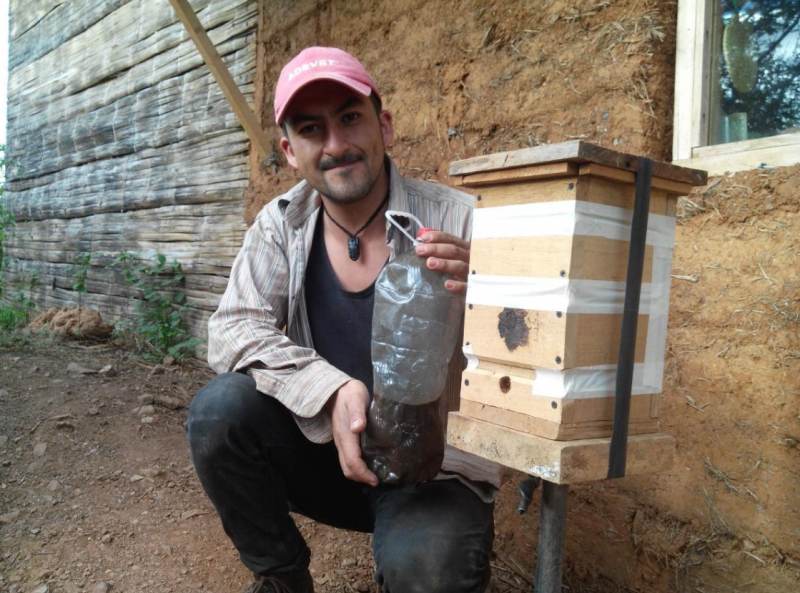
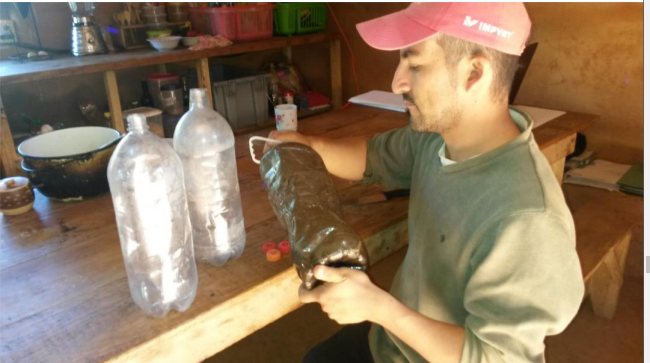
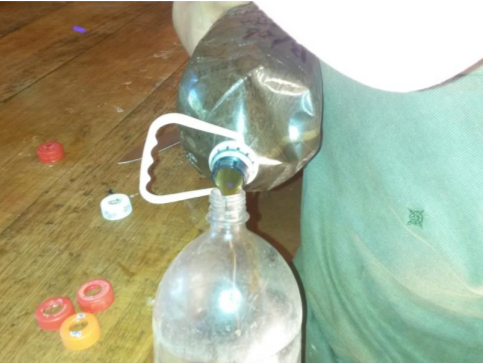
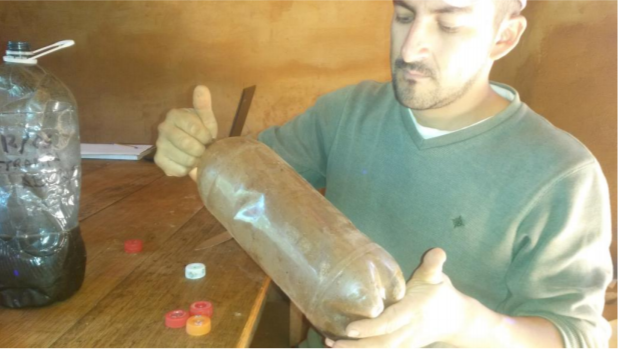
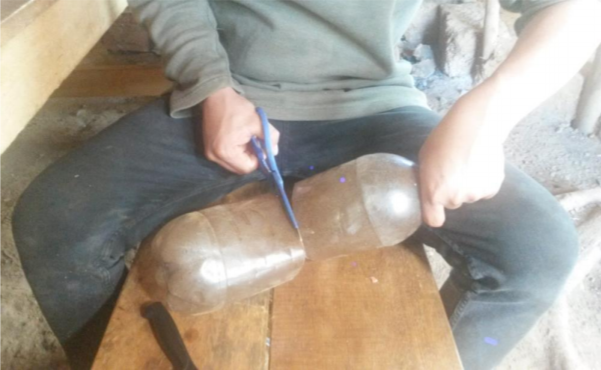
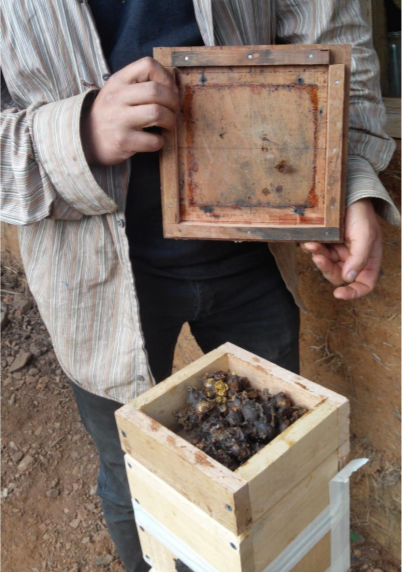
 Français
Français English
English Deutsch
Deutsch Español
Español Italiano
Italiano Português
Português